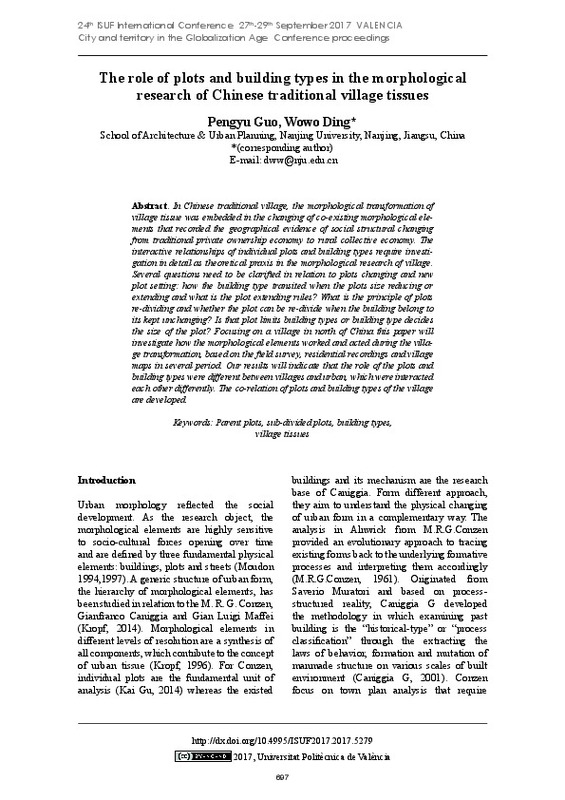JavaScript is disabled for your browser. Some features of this site may not work without it.
Buscar en RiuNet
Listar
Mi cuenta
Estadísticas
Ayuda RiuNet
Admin. UPV
The role of original plots and building types in the morphological research of Chinese traditional village tissues
Mostrar el registro sencillo del ítem
Ficheros en el ítem
| dc.contributor.author | Pengyu, Guo
|
es_ES |
| dc.contributor.author | Wowo, Ding
|
es_ES |
| dc.coverage.spatial | east=104.19539699999996; north=35.86166; name= Xina | es_ES |
| dc.date.accessioned | 2018-12-14T08:14:57Z | |
| dc.date.available | 2018-12-14T08:14:57Z | |
| dc.date.issued | 2018-04-20 | |
| dc.identifier.isbn | 9788490485743 | |
| dc.identifier.uri | http://hdl.handle.net/10251/113752 | |
| dc.description.abstract | [EN] In Chinese traditional village, the morphological transformation of village tissue was embedded in the changing of co-existing morphological elements contains original plots, that recorded the geographical evidence of social structural changing from traditional private ownership economy to rural collective economy. The internal relationships of original plots, derivative plots and building types require investigation in detail as theoretical praxis in the morphological research of village. Several questions need to be clarified: is that the plot restricted to the block, or the plots constitute the block? Is that plot limits building types or building type decides the size of the plot? Whether the plot can be re-divided when the building belong to its kept unchanging? And how the building type transited when the plots size reducing or extending? Focusing on a village in north of China this paper will investigate how the morphological elements worked and acted during the village transformation, based on the field survey, village records and the family documents. Our results will indicate that the role of the street, plots and building types were different between villages and urban, which were interacted each other differently. The concepts derivative plots and the co-relation between the plots, the derivative plots and building types of the village are developed. | es_ES |
| dc.description.sponsorship | This study was financially supported by Major Program of National Natural Science Foundation of China (No.51538005). | es_ES |
| dc.format.extent | 11 | es_ES |
| dc.language | Inglés | es_ES |
| dc.publisher | Editorial Universitat Politècnica de València | es_ES |
| dc.relation.ispartof | 24th ISUF International Conference. Book of Papers | es_ES |
| dc.rights | Reconocimiento - No comercial - Sin obra derivada (by-nc-nd) | es_ES |
| dc.subject | Parent plots | es_ES |
| dc.subject | Sub-divided plots | es_ES |
| dc.subject | Building types | es_ES |
| dc.subject | Village tissues | es_ES |
| dc.title | The role of original plots and building types in the morphological research of Chinese traditional village tissues | es_ES |
| dc.type | Capítulo de libro | es_ES |
| dc.type | Comunicación en congreso | es_ES |
| dc.identifier.doi | 10.4995/ISUF2017.2017.5279 | |
| dc.relation.projectID | info:eu-repo/grantAgreement/NSFC//51538005/ | es_ES |
| dc.rights.accessRights | Abierto | es_ES |
| dc.description.bibliographicCitation | Pengyu, G.; Wowo, D. (2018). The role of original plots and building types in the morphological research of Chinese traditional village tissues. En 24th ISUF International Conference. Book of Papers. Editorial Universitat Politècnica de València. 697-707. https://doi.org/10.4995/ISUF2017.2017.5279 | es_ES |
| dc.description.accrualMethod | OCS | es_ES |
| dc.relation.conferencename | 24th ISUF 2017 - City and Territory in the Globalization Age | es_ES |
| dc.relation.conferencedate | Septiembre 27-29,2017 | es_ES |
| dc.relation.conferenceplace | Valencia, Spain | es_ES |
| dc.relation.publisherversion | http://ocs.editorial.upv.es/index.php/ISUF/ISUF2017/paper/view/5279 | es_ES |
| dc.description.upvformatpinicio | 697 | es_ES |
| dc.description.upvformatpfin | 707 | es_ES |
| dc.type.version | info:eu-repo/semantics/publishedVersion | es_ES |
| dc.relation.pasarela | OCS\5279 | es_ES |
| dc.contributor.funder | National Natural Science Foundation of China | es_ES |








